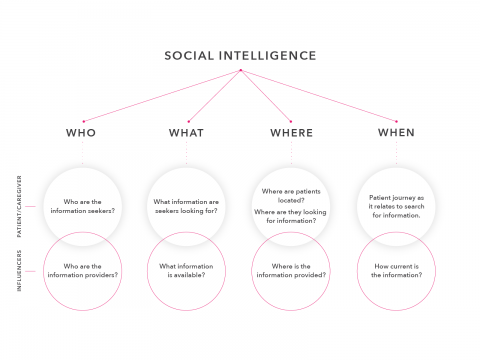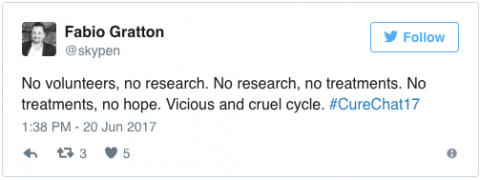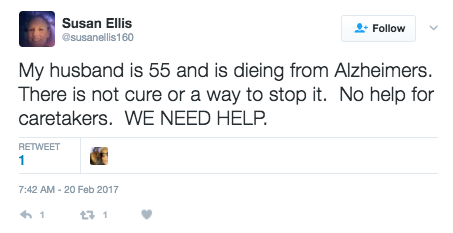When it comes to healthcare we know that consumers actively participate in social media to seek information and find support. More than 40% say that information from social media affects how they cope with a chronic condition, their approach to diet and exercise, the physician they select and even their decision to seek a second opinion1.
Social media offers real-time engagement that can generate high volumes of information around a variety of health conditions, almost instantly. In monitoring these conversations, we’re able to uncover trends, behaviors and gaps in information being sought within patient communities.
By leveraging these community insights we create valuable new data sources for drug development. These insights can drive efficiencies when it comes to recruiting volunteers for clinical studies. How? By activating online patient influencers with effective messaging and large, highly engaged social networks, we can significantly improve trial awareness.

Why is Social Listening Important?
Social listening serves two purposes; a.) It enables us to track real-time conversations by indication and b.) Offers an opportunity to engage with patients who can help shape study design and influence feasibility by providing untapped datasets and insights.
Patients play an important role in helping to spread awareness about research and its potential in developing new treatment options to improve quality of life. In turn, this can dispel common misconceptions about clinical studies and increase the pool of potential participants.
How Social Listening Can Help Alzheimer’s Research
Alzheimer’s is one of the top ten causes of death in mid-high income economies globally2. It cannot be prevented, cured, or slowed. In the United States 2017 is the first year in which the cost of care associated with Alzheimer’s will surpass a quarter of a trillion dollars3, making this disease not only deadly, but expensive.
Despite the personal and monetary costs, Alzheimer’s research consistently suffers from low participation rates. Fewer volunteers mean less data from trials that could contribute to treatments and cures.
According to the Alzheimer’s Association, at least 50,000 volunteers will be needed across 500 studies4 that are either recruiting or preparing to recruit for clinical studies.
To describe this situation in terms of a traditional product/service sales business model, “our company” (clinical research) is failing to meet its customer quota (recruitment) and the methods in which we attract our customers are proving costly for little benefit. If we’re failing to attract “customers”, it’s likely for two reasons: We aren’t looking in the right places to find them and/or our message isn’t resonating with them. Effective social engagement can help us fix that and do it in a way that is efficient and cost effective.
In addition, 39% of consumers use social media networks5 (with Facebook as the top performer) as inspiration for purchases. Not only that, but as of May 2017, there were 1.94 billion active users on Facebook per month (with 1.15 billion of those accessing Facebook through their mobile devices) , 700 million users on Instagram, 175 million users on Pinterest, 1 billion users on YouTube (with 4 billion views per day), 166 million users a day on SnapChat and 328 million users on Twitter6.
Patients want to be heard and understood. We know that thousands of people across hundreds of Alzheimer’s groups on Facebook discuss current treatments, their struggles, and they provide support for one another on a daily basis. Patient advocates on Twitter, Instagram, and Snapchat put a human face to the realities of the condition. Effective social listening strategies allow us to embrace these communities and give us insight into their needs and concerns.



By 2050, the number of people diagnosed with Alzheimer’s globally is expected to triple7, barring the development of medical breakthroughs to prevent or cure it. The costs of Alzheimer’s affect all of us, directly or indirectly, personally and financially. These costs will only worsen over time. Harnessing the power of social media we can get closer to finding new treatments.
By: Claire Russell, Executive Director, Patient Experience
______________________________________________________________________________
1 "24 Outstanding Statistics & Figures on How Social Media Has Impacted the Health Care Industry.” https://getreferralmd.com/2013/09/healthcare-social-media-statistics.
2 World Health Organisation.http://www.who.int/mediacentre/factsheets/fs310/en/index1.html http://www.who.int/mediacentre/news/releases/2012/dementia_20120411/en/
3 Alzheimer’s Association. 2017 Alzheimer’s Disease Facts and Figures. http://www.alz.org/documents_custom/2017-facts-and-figures.pdf
4 http://www.alz.org/research/you_can_help/participate_in_alzheimers_research.asp
5 PWC. “10 retailer investments for an uncertain future.” Total Retail 2017 https://www.pwc.com/gx/en/industries/assets/total-retail-2017.pdf
6 Zephoria Digital Marketing. “The Top 20 Valuable Facebook Statistics – Updated June 2017.” https://zephoria.com/top-15-valuable-facebook-statistics/
7 Alzheimer’s Association. https://www.alz.co.uk/research/statistics
For similar articles please visit Wavelength, by PRA Health Sciences.